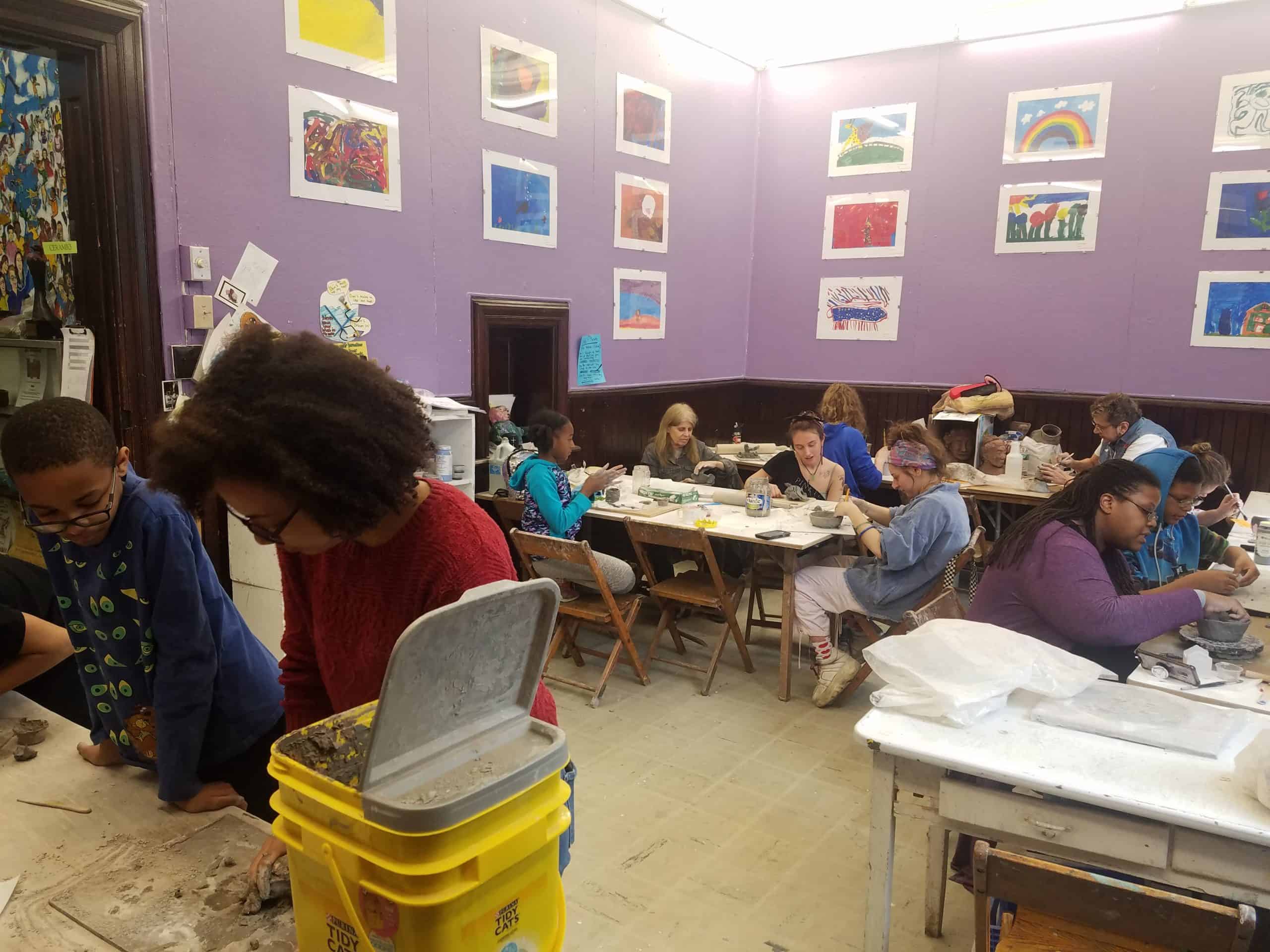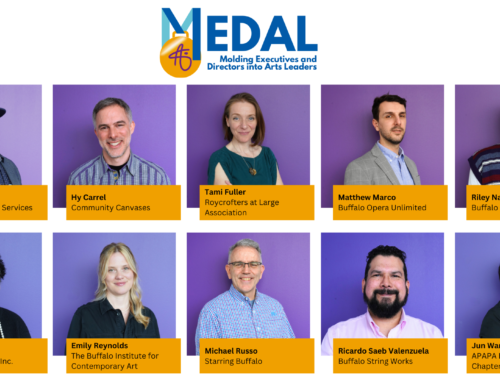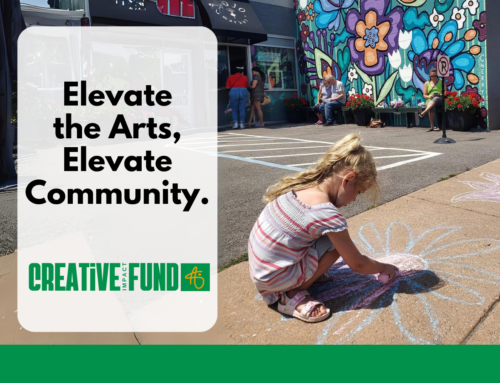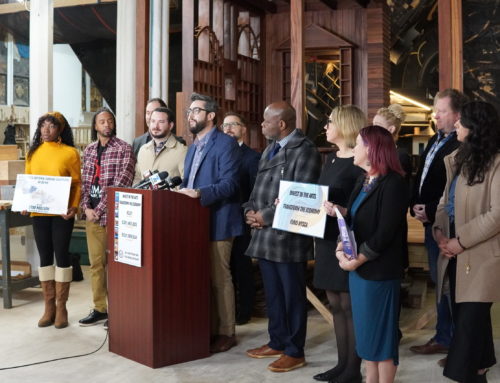Locust Street Art (LSA) is a nonprofit arts organization that has provided free studio art classes and low-cost specialized workshops and custom services for both children and adults since 1959. Its roster of teaching artists reflects specializations in painting, drawing, ceramics, animation, photography, and more.
For this month’s Accessibility in the Arts spotlight, we sat down with LSA Executive Director Rachelyn Noworyta to learn more about the organization and its vision for the future.
ASI: First of all: Happy 60th anniversary to LSA! Tell me a little about the history of your organization. Why and how did it begin?
RN: Thank you! LSA, formerly MollyOlga, started in 1959 when a young girl, who was interested in learning to paint and draw, saw Molly Bethel painting on the front porch of her home on the East Side of Buffalo. The young girl asked Molly if she was an artist and if Molly could teach her. Shortly after that, the neighborhood kids who wanted to learn about art seemed to multiply exponentially, and Molly soon had a kid drawing and painting in every corner of her home.
After seeing the impact that art had on these young children, Molly expanded her programming and began offering classes at St. Phillips Episcopal Church in the late 1960s. She met Olga Lownie there, who was pursuing a degree in art education at SUNY Buffalo State College. Together, they formed MollyOlga. St. Phillips was right in the path of the new Kensington Expressway, and “Urban Renewal” and gentrification claimed St. Phillips, forcing MollyOlga to find a new home. The nuns of St. Boniface offered the two front rooms of their convent on Locust Street in the Fruit Belt to MollyOlga. Often, art instruction would take place with the sound of the parish nuns in the background!
When St. Boniface officially closed its doors in the early 1970s, the convent was placed up for sale and the community banded together to purchase the building. Collection jars were placed in local businesses, and after enough funds were raised, the keys to the building were placed with MollyOlga, cementing its future as an anchor to Western New York’s arts community.
Today, LSA continues to provide free art education programs in ceramics, photography, drawing, painting, and studio animation for both children and adults. Expanded off-site services bring additional arts programs to hundreds of students in local schools and community centers.
ASI: When did you first get involved with LSA? How have you seen the organization evolve in the time since?
RN: I first became involved with LSA in 2015 as its ceramics instructor. I very quickly fell in love with the organization, as most people do. As its outreach grew, I was given the opportunity to become further involved with the organization and coordinate off-site art classes. In 2018, the position for Executive Director opened up and I jumped at the chance to fulfill this role.
Over the last five years, I have had the pleasure of helping this wonderful organization grow alongside some of the best people I know. Within that time, LSA was able to bring its photography classes into the digital age by providing students with DLSR cameras, animation classes were kicked up a notch with computer/digital animation, and pottery wheels were added to the existing ceramics classes. At LSA, it is our focus to do everything we can to enhance the experience of the student.
Not only has LSA expanded its equipment, but it has also expanded its programs. Three years ago, we added the Young Artist Summer Camp to our barren summers and we’ve been adding workshops and smaller camps ever since. Two years ago, LSA implemented free specialized workshops on Saturdays throughout January and February when regular free classes are on break. Throughout the year, LSA offers very low-cost focused workshops in different artforms and mediums, such as stop action animation, intro to oil paint portraiture, and intro to the potter’s wheel—to name a few. Now, there is never a time when LSA doesn’t have programming going on. Art should be accessible to everyone; the more programming we are able to supply, the more accessible we become.
ASI: Tell me about a moment when you witnessed the impact of Locust Street Art.
RN: Oh my! There are so many impactful moments at LSA that run deep and span generations of students. Listening to people’s stories of the organization is something that I treasure. Most have a common theme: “My grandparents brought my parents, then they brought me, and now I bring my own kids.” I could talk for days about how LSA shapes people’s lives for the better, but I will choose just a few:
- A teenaged ceramics student of ours is one of seven children, all of whom take part in a variety of classes. One day, I noticed her as she worked so intently on a sculpture, she was simply beaming, and it dawned on me: LSA is a place where she can be an individual and shine.
- During one of our annual art shows, I witnessed a little boy, who could not have been more than four years old, march into LSA with gusto—on a mission. He got a few feet past the doorway and he stopped abruptly, looked around him at the art hanging on the walls, and in the most awe-inspired whisper exclaimed “wow!” It might have been his first time viewing art in a gallery setting.
- LSA is a place of healing as well. An adult student, who had been working on a painting for weeks, opened up to discuss her work with the instructor. She said that LSA was a place that she felt safe and could use art as a tool to work through her past trauma of violence.
ASI: Are there any individuals, organizations, or programs within Western New York or beyond that have influenced or helped to shape your vision for the organization? Is there anyone you’d like to shout out?
RN: Our students and community are really the ones who help shape the vision of LSA. As a whole, LSA’s board and staff come together to foster the needs of our students.
I’d really like to give a shout-out to Frontline Arts Buffalo (FAB), which advocates for the needs of arts organizations in frontline communities. Frontline communities, such as the Fruit Belt, are the first and worst impacted when it comes to any kind of ecological, social, and economic change. Arts organizations that serve frontline communities must provide multi-faceted support, but never receive adequate funding. At LSA, we do so much more for our community than simply provide free art instruction—we offer youth mentoring and development with our teen assistants, we provide wellness services, and we are always available if anyone needs to talk.
FAB has been advocating around a number of crucial issues as it relates to arts funding and representation in Buffalo. Most notably, FAB worked with Erie County Legislator April Baskins and her office to completely re-work the Erie County Cultural funding process and make it much easier for smaller organizations, including LSA and other frontline arts organizations. Our past Executive Director, Dorothea Braemer, was active with FAB, as are two of LSA’s board members, Zainab Saleh and Heather Gring. LSA is considered a founding member of FAB, and we are so proud of the work they continue to do!
ASI: With regard to accessibility—and especially, in the case of Locust Street Art, financial accessibility—what kinds of things would you like to see from arts and cultural organizations in Western New York? What can our community do better?
RN: More free programming. Some organizations offer discounted rates, partial scholarships, and the occasional “free day,” but our students need more. Additionally, we would love to see more organizations make a conscious effort to serve minority groups and people of color. The reason LSA came into existence is because nobody was offering visual arts education to people of color in our community, and if they were, it was costly. If you’re a theater company or museum that only ever sees the same group of people come through your doors, make the effort to involve new people in your decision-making, bring your show or exhibit to an East or West Side venue, or advertise job openings and new classes in minority-owned publications. It can be an uncomfortable conversation for some, but it should be a part of every organization’s planning. You’d be surprised how easy it is to involve new people in your organization if you just make the effort.
We all exist to serve our community. If we’re not making an extra effort for those that need our support the most, is that community service or just a perk for a select group of people?
ASI: As you know, the arts and cultural sector has been hit hard by the COVID-19 crisis. Do you have any ideas, recommendations, or general words of advice for your fellow arts administrators during this difficult time?
RN: This crisis affects every institution in a different way. However, there’s two things everyone should be focusing on as we navigate this difficult time: mission and vision. Each of our organizations exists for a reason. Now is a time to reflect on our purposes and find new ways to deliver our programs to our constituents, whether that means going online, developing programs that can move off-site, or finding new organizations to team up with to cut on costs or reach a wider audience.
On top of that, ask where you see your organization in one year, five years, or 100 years down the road. COVID-19 isn’t just a barrier, it’s a transition. Knowing where you want to go can really help you cement the path.
We’re all in this together and one strange benefit of not having our doors open is that we have to think outside the box. Try something new every day and eventually something great will stick. We never thought about offering all of our classes online, and now we think it’s an essential addition to our standard programming!
ASI: How have you needed to adapt your programming in response to COVID-19? What are some of the challenges you’re facing? Have you been surprised by any unexpected advantages?
RN: We were actually scheduled to begin spring classes the weekend before we were all forced to close our doors. So right off the bat we knew that in-person classes weren’t going to be an option.
Our first thought was toward our teachers. If they weren’t on payroll, classes weren’t an option. We quickly set up two new online formats: a YouTube do-it-yourself series, and weekly zoom classes where our students could interact with their teachers. The response has been overwhelmingly positive, so we’ve decided to make it a staple feature of our yearly programming.
In addition to the usual challenges that COVID-19 has presented, one of our biggest concerns moving into the fall is whether or not we will be able to hold live classes. If not, we’ve discussed how we can deliver art supplies such as clay, paint, brushes, and more to students in need.
Perhaps one of the biggest blessings in disguise is that we’ve been forced to think about what the future might hold. Too often, it’s easy to focus on day-to-day activities. Now our board and staff are thinking from a more strategic, long-term position. That includes talking about how to manage our cash reserves, measure impact, and where to place our priorities.
ASI: What’s next for Locust Street Art?
RN: While we are excited to reopen our doors and have the buzz of creation swarming the building, we air on the side of caution. At the moment, we are coordinating virtual and extremely low-cost workshops for the summer months, which is typically the only time we do not have full-scale free programming (though we offer full scholarships to anyone who needs it). These workshops include Inspired Painting and Paper Mache, Painting in the Park, Painting with Light, and The Art of Storyboarding, all of which will have art packages included and delivered with everything needed for the workshops. We hope to keep up momentum and add more as we navigate the coming months. Once the workshops are finalized, all information and how to sign up will be on our website at locuststreetart.org.
As for the fall, we will have free classes as usual, whether virtually or in person. We hope for the latter, but continue to monitor the situation and will not move forward with any decision that puts our teachers and students at risk.






